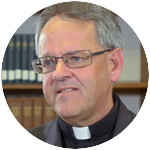
Father Thomas Dailey, O.S.F.S.
Talk of a “new normal” is now commonplace. When extraordinary conditions last beyond the onset of some upheaval, how we respond turns into what we ordinarily do moving forward.
So it will be with a post-COVID-19 society. That includes how we live in and as the church.
For Christians, the idea of a “new normal” shouldn’t really be new. After all, the Easter season celebrates the most significant upheaval of all time — when the crucified Lord arose to new life. The Resurrection changed everything! Christian life ever since is predicated on this new reality.
[hotblock]
Pope Francis recently pondered how our Resurrection faith affects our approach to the current global health crisis. In his reflection, the pope presents a “plan for rising again” founded on Easter hope (which “cannot become infected”), realized in the community of disciples (because “no one is saved alone”) and leading toward an “alternative civilization of love.”
The pope’s lofty meditation inspires a “new normal” in terms of how we think about our common human existence. But can we translate this vision into the reality of church life? What might the “new normal” of a parish look like after the pandemic passes?
The extraordinary events of that first Easter can shed light on how we emerge from this 21st century crisis. To restore pastoral life, we need to re-engage our faith in the Resurrection to appreciate what our “new normal” will be. In terms of parish planning, what might this mean?
The biblical narratives relate numerous appearances of the risen Jesus to his disciples. Key to those encounters is a sense experience. They see him, they hear him, they touch him, they even dine with him.
Parishes may consider designing sense-experiences for the faithful to signal the change in our current state of quarantine. Lighting up parish buildings, ringing church bells, hosting musical concerts, offering “give-aways” of some sort — anything that can communicate a sense of “joy” at arising out of the crisis will draw parishioners together, even if they still have to distance themselves socially.
Tales of Easter turn on the disciples’ recognition of the risen Lord, and his transformed presence inspires a newfound appreciation of all that he had previously said and done.
[tower]
Parishes might plan Masses or other celebrations to recognize particular groupings of the faithful, with prayers for those impacted by the crisis (the deceased or those still sick) and gratitude for those contributing to the common good during it (e.g., healthcare professionals or public safety personnel).
In the Gospel stories, the miracle of the Resurrection is often linked to a meal. In the breaking of bread at Emmaus, or at breakfast on the shore with the fishermen, the disciples encounter the risen Jesus when gathered together in his midst.
So, too, the parish community will again be able to gather in-person to encounter Jesus present in the sacraments. Parishes need to strategize about how this will take place given probable restrictions on the size of the congregation, necessary procedures for ensuring safe spaces, and ritual changes to account for social distancing.
In their final gathering in Galilee, the risen Lord commissions his disciples to “go and make disciples of all nations.” That mission continues! Church buildings may have been closed, but doors to the church were opened even wider via social media.
Capitalizing on the innovative ways they reached out to people during the crisis, parishes must consider how to advance their evangelizing efforts with technology. So many more people were “present” in parishes electronically than had been physically that continuing to “go out” to them represents a missionary opportunity not to be lost. Engaging in robust digital communications to make disciples may be the most decisive feature of a parish’s “new normal.”
Finally, the first disciples’ experience of the Resurrection led to the formation of a “community of believers (that) was of one heart and mind” (Acts 4:32). In the “new normal” of the post-pandemic parish, the entire parish community will need to share responsibility. Patience and support will surely be required!
Parishes should seize this opportunity, as Katherine Kersten writes, to see themselves as more than producers/consumers of spiritual services and to become a vital spiritual community that bears witness to the Resurrection.
In Pope Francis’s meditation, the image of the stone rolled away from the tomb at Easter invites us to contemplate the painful reality of the current pandemic with a renewed outlook. With intentional planning, that outlook will inform the “new normal” arising in parish life — where believers, sort-of believers, and even non-believers may once again rejoice.
* * *
Father Thomas Dailey, O.S.F.S. is the John Cardinal Foley Chair of Homiletics and Social Communications at St. Charles Borromeo Seminary, Wynnewood, and a research fellow for the Catholic Leadership Institute in Wayne.
PREVIOUS: Not to lay off: You have staffing options during COVID-19 crisis
NEXT: Let go of your autopilot, trust radically in God’s love



Share this story